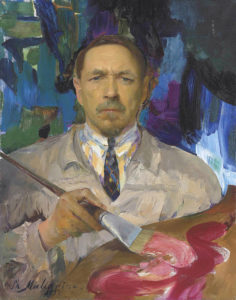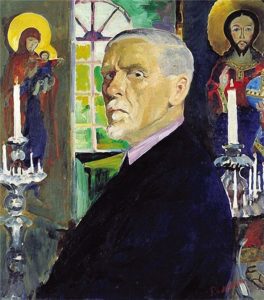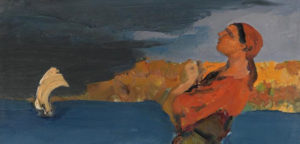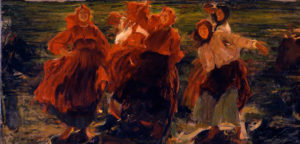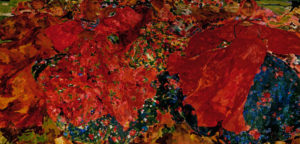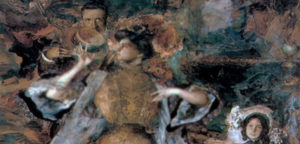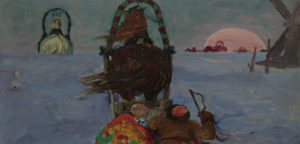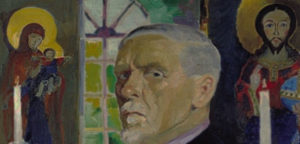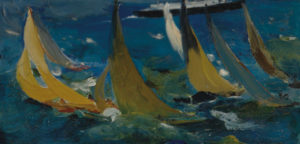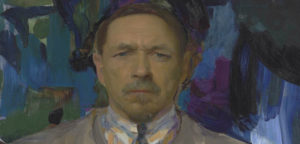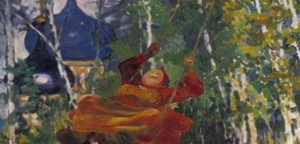Filipp Malyavin was born on October 23, 1869 in the village of Kazanka, Buzuluk county of the Samara province.
1869 - 1940
Filipp Malyavin
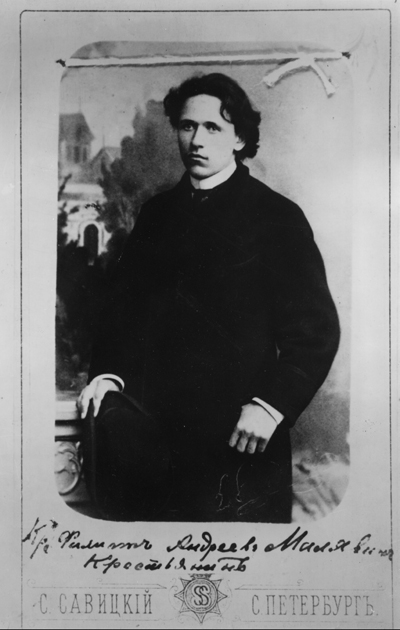
description
An outstanding Russian painter, portraitist and graphic artist, a singer of peasantry.
The artist was born into a family of poor state peasants, who had many children. He started drawing early, copying icon-painting images at the age of four to five, later painted portraits of fellow villagers, sculpted figures from clay. He quickly learned to read and write from a retired sergeant major.
The master of the peasant theme in a very temperamental and peculiarly variegated interpretation, Philip Malyavin became famous in Russia and abroad. The decorative-epic and very recognizable “Malyavinian” manner began with picture “Laughter”, which became the diploma work of the graduate of the Academy and caused a scandal, and then was exhibited at the World Exhibition in 1900 in Paris, where it received “gold”. Laughing peasant women in red, monstrously bright sarafans, put in the center against a background that is difficult to read, are performed pasty and with such a transfer of emotion that one cannot simply not smile.
A member and participant of exhibitions of associations “World of Art”, “Union of Russian Artists”, the author of historically significant images of Lenin and his associates, painted from real life. As a talented portraitist, he left hundreds of paintings and drawings that convey the appearance of outstanding and significant personalities not only of Russia but also of Europe.
Key ideas of the artist:
The series of wholeheartedly singing, flying on the swings, dancing, rural residents playing the harmonies are the main theme of the original painting of Malyavin. He quickly established himself in his decorative and monumentally interpreted peasant theme, and his magnificent girls and women really conquered by the brilliance of colors, the sonority of the stories and, most importantly, the expression of the “intuitive”, “true” and mysterious power of the people.
After the holidays, Filipp brought from his native Samara village “marvelous by the image and painting” compositions, portraits that amazed “with a holistic perception of the model and a deep penetration into the character” (quotes from the memoirs of his fellow student A. Ostroumova-Lebedeva). It is surprising that such an artist became also the creator of the “Leninian”, painted from the nature quite “decent” (almost academic) portraits of Trotsky, Lunacharsky, artists Repin (his teacher), Grabar, Somov, etc. Never parting with the album, he sketched almost all whom he studied with, met at “The World of Art”, at “The Union of Russian Artists”, at exhibitions.
A special feature of the plot portraits and genre scenes of Malyavin was that each character performed its task. In the flaming chaos of flowing smears, the dark faces of the peasants, carefully painted, became particularly significant. It is shown by a canvas with eloquent name “Whirlwind” (1906), which brought the artist special fame.
Also known are ordered portraits by Malyavin, who for a long time was known as a fashionable portraitist in Russia and Europe. One of the best ones is the pair portrait of industrialist, patron of arts and creator of the Kharkov estate of Natalyevka Pavlo Kharitonenko and his son. This line of creativity is heterogeneous in its value due to the presence of external effects and mannerisms. Later, in the emigration, the peasant images began to recur and lose their vitality.
1869
1885 - 1891
1892 - 1899
1900 - 1901
1906
1911
1917 - 1919
1922
1930
1940
1940
The birth of the artist
Together with his friend monk, he went to the monastery of St. Panteleimon on Mount Athos
Together with his friend monk, he went to the monastery of St. Panteleimon on Mount Athos to study church painting. His fellow villagers helped him collect money for the long travel – their faith in the talent of the teenager was great. Five years later, V. Beklemishev, a Russian sculptor who arrived to the Sacred Mountain, became interested in the works of his compatriot and the novice, inviting him to enter the Imperial Academy of Arts.
Entered the Academy of Fine Arts in St. Petersburg
Entered the Academy of Fine Arts in St. Petersburg. At first he was a free listener. Extremely able to study, the former icon painter mastered the program of the main class in two months, graduated from the figure class after two more months, and two years later moved to the workshop of I. Repin, got acquainted with Grabar, Somov, Kustodiev, Ostroumova, A. Murashko. The successes of Filipp in the prestigious educational institution were brilliant.
At the insistence of Repin, participated in the Paris World Exhibition with the picture "Laughter"
At the insistence of Repin, participated in the Paris World Exhibition with the picture “Laughter”, rejected by the Academic Council of professors as a thesis. In Paris, the work was a great success, and the author received a gold medal. In the following year, success was repeated at the Venice Biennale, the picture was acquired by the Ca’Pesaro gallery.
Actively participated in exhibitions of the Association of Wanderers
Actively participated in exhibitions of the Association of Wanderers and the “World of Art”, “36 artists” and “Union of Russian Artists”, in “The Salon” arranged by Diaghilev in Paris, at the Secession exhibitions in Berlin, Munich, Rome. He received the title of Academician of Painting, left for a foreign voyage for three years. Met I. Mechnikov, whose portrait he painted. Upon his return, the “Ryazan” period of his work began. Settled in Denezhnikovo estate in his own countryseat, which he managed to buy, soon having become a famous person in the art world, having solid fees from a wealthy clientele in the capitals of Russia, and improved his financial prosperity in Europe.
"Self-Portrait with the family"
Resumed the exhibition activity, showing “Self-Portrait with the family,” which the artistic community and most critics described as a creative fiasco. Nevertheless, he recovered from the punch and took part in the exhibitions “World of Art” and The Union of Russian Painters.
He tried to adapt to the realities of life after the revolution
He tried to adapt to the realities of life after the revolution: was engaged in cultural and educational activities among the masses, arranged an art gallery in Ryazan, taught at art workshops. The Provincial Department of the People’s Commissariat of Education in Ryazan organized the solo exhibition for the 50th anniversary of Malyavin. Having a “security letter”, the artist saved the product from nationalization and soon took the main part of them abroad.
He emigrated from Moscow to France
He emigrated from Moscow to France with his family under the pretext of organizing a traveling exhibition. In 1924, the second personal exhibition took place at the Parisian gallery Charpentier (timed to the 55th anniversary). The family moved to Nice.
A burst of creative activity
A burst of creative activity: almost every year there were personal exhibitions in the cities of England and Denmark, Italy and Norway, Czechoslovakia and Sweden, Yugoslavia and, of course, France. One of the largest expositions of 1933 in Prague – the works were located in the five halls of the pavilion Myslbek in the historic center of the Czech capital. He experimented with genres of marina, winter landscapes and strengthened his glory of a brilliant salon portraitist, having orders for portraits of the members of the royal houses of Europe, representatives of bohemia and cultural figures from the Russian abroad. The last solo exhibition was held in 1939 at the artist’s studio in Nice.
The artist was arrested
When he was in occupied Brussels, the artist was arrested on suspicion of espionage. The Gestapo officer, who turned out to be an art lover, let the 70-year-old go, but the road to home on foot exhausted his strength. After reaching Nice, he was in the clinic.
The death of the artist
Filipp Malyavin passed away on December 23, 1940 in Nice, France.

